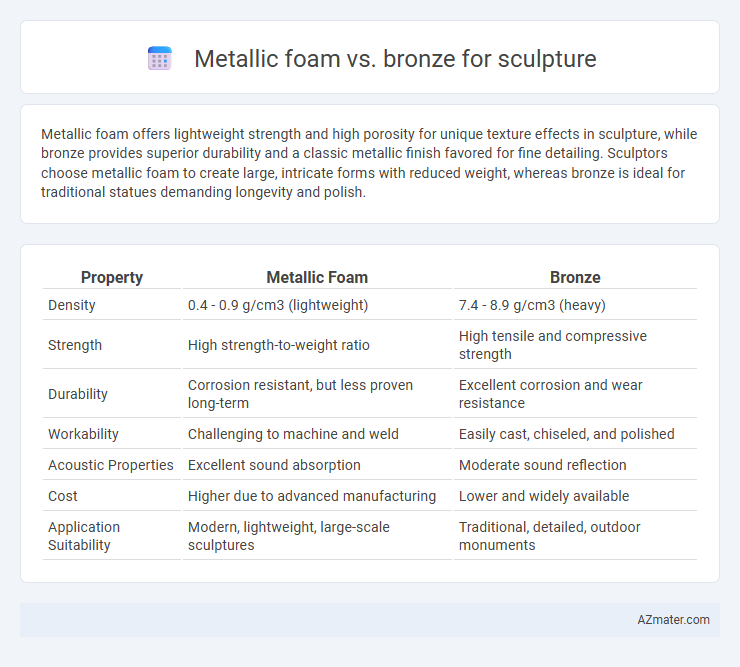Metallic foam offers lightweight strength and high porosity for unique texture effects in sculpture, while bronze provides superior durability and a classic metallic finish favored for fine detailing. Sculptors choose metallic foam to create large, intricate forms with reduced weight, whereas bronze is ideal for traditional statues demanding longevity and polish.
Table of Comparison
| Property | Metallic Foam | Bronze |
|---|---|---|
| Density | 0.4 - 0.9 g/cm3 (lightweight) | 7.4 - 8.9 g/cm3 (heavy) |
| Strength | High strength-to-weight ratio | High tensile and compressive strength |
| Durability | Corrosion resistant, but less proven long-term | Excellent corrosion and wear resistance |
| Workability | Challenging to machine and weld | Easily cast, chiseled, and polished |
| Acoustic Properties | Excellent sound absorption | Moderate sound reflection |
| Cost | Higher due to advanced manufacturing | Lower and widely available |
| Application Suitability | Modern, lightweight, large-scale sculptures | Traditional, detailed, outdoor monuments |
Introduction to Sculpture Materials
Metallic foam offers a lightweight alternative to traditional bronze in sculpture, combining structural strength with unique porous textures that enhance aesthetic appeal. Bronze remains a classic choice known for its durability, fine detail capture, and resistance to corrosion, making it ideal for outdoor monuments. Selection between metallic foam and bronze depends on factors like weight, finish, and the desired visual impact of the sculpture.
Overview of Metallic Foam in Art
Metallic foam offers unique advantages in sculpture due to its lightweight structure, high porosity, and exceptional strength-to-weight ratio, enabling artists to create large-scale, intricate works that maintain structural integrity. Its cellular architecture provides a distinctive texture and visual appeal that contrasts with traditional bronze, allowing for innovative expressions in contemporary art. This material's corrosion resistance and ability to interact with light enhance sculptures with dynamic aesthetics and durability in outdoor installations.
Properties of Bronze in Sculpture
Bronze, an alloy primarily composed of copper and tin, has been a preferred material for sculpture due to its excellent durability, corrosion resistance, and ability to capture fine details during casting. Its density and malleability allow artists to create intricate, large-scale works with stable structural integrity, while the natural patina developed over time enhances the aesthetic value. Unlike metallic foam, bronze offers a traditional, timeless appeal combined with a proven longevity that withstands outdoor environmental exposure.
Weight and Structural Considerations
Metallic foam offers a significantly lighter alternative to bronze for sculptures, reducing overall weight without compromising rigidity due to its cellular structure. Bronze, known for its high density and excellent durability, provides superior load-bearing capacity but requires stronger support systems for larger installations. Choosing metallic foam enhances ease of transport and installation, while bronze guarantees long-term structural stability and resistance to environmental factors.
Artistic Versatility and Aesthetic Appeal
Metallic foam offers exceptional artistic versatility due to its lightweight structure and unique porous texture, allowing sculptors to create complex, large-scale forms with intricate surface details. Bronze provides timeless aesthetic appeal with its rich, warm patina and durability, enabling fine detailing and a classical finish preferred in traditional sculptures. Choosing between metallic foam and bronze depends on the desired visual impact and structural requirements, balancing innovation with historical elegance.
Durability and Longevity
Metallic foam offers superior corrosion resistance and lightweight durability compared to bronze, making it ideal for sculptures exposed to harsh outdoor environments. Bronze, with its proven centuries-long endurance and resistance to weathering through patina formation, remains a hallmark of longevity and structural strength. Both materials provide lasting aesthetic appeal, but metallic foam's innovative composition often results in reduced maintenance and enhanced resistance to environmental degradation.
Surface Texture and Finishing Options
Metallic foam offers a unique porous surface texture that creates a lightweight, visually dynamic finish ideal for modern sculptures, while bronze provides a smooth, dense surface that is highly polishable and traditional for fine details. The finishing options for metallic foam include powder coating, anodizing, and clear sealing to preserve its distinctive texture and corrosion resistance. Bronze, on the other hand, supports patination, waxing, and polishing techniques that enhance its rich color variations and durability in outdoor environments.
Cost Comparison: Metallic Foam vs Bronze
Metallic foam offers a cost-effective alternative to bronze for sculpture, with production costs significantly lower due to reduced material weight and simpler manufacturing processes. Bronze pricing fluctuates based on copper and tin market values, often resulting in higher expenses for large or intricate sculptures. Maintenance costs also favor metallic foam, as it resists corrosion better than bronze, lowering long-term preservation expenses.
Environmental Impact and Sustainability
Metallic foam offers significant environmental benefits in sculpture due to its lightweight nature, requiring less raw material and energy during production compared to bronze, which is energy-intensive and heavily reliant on mining activities. The recyclability of metallic foam enhances sustainability, as it can be reused or repurposed with minimal waste, whereas bronze alloys often involve complex recycling processes that may release toxins. Choosing metallic foam reduces the carbon footprint of sculptures, aligning with eco-friendly art practices by minimizing resource extraction and promoting circular material use.
Choosing the Right Material for Your Sculpture
Metallic foam offers lightweight durability and unique texture, making it ideal for large-scale, intricate sculptures requiring ease of handling and corrosion resistance. Bronze provides timeless strength, excellent detail retention, and exceptional patina development, suitable for traditional, long-lasting artistic works. Selecting between metallic foam and bronze depends on factors such as desired weight, finish, environmental exposure, and longevity requirements.

Infographic: Metallic foam vs Bronze for Sculpture
 azmater.com
azmater.com